International Health: Reflective Cycle Analysis of a Hospital Incident
VerifiedAdded on 2023/01/17
|8
|1844
|35
Report
AI Summary
This report applies the Gibbs Reflective Cycle to analyze an incident in a mental health hospital where a patient self-harmed and another escaped. The student, acting as a shift coordinator, describes the situation, including the staff's reactions, feelings, and the unit manager's response. The evaluation phase highlights the ability to listen to staff concerns and the need for improved resource management. The analysis identifies issues such as staff shortages, lack of training, and poor communication. The conclusion emphasizes the need for efficient resource management, staff training, and improved communication to prevent similar incidents. The action plan proposes assigning fewer patients to each nurse, providing behavioral training for staff, and improving communication between all parties involved to enhance patient care and safety. The report provides a detailed reflection on the incident, offering insights into healthcare management and patient care within an international health context.
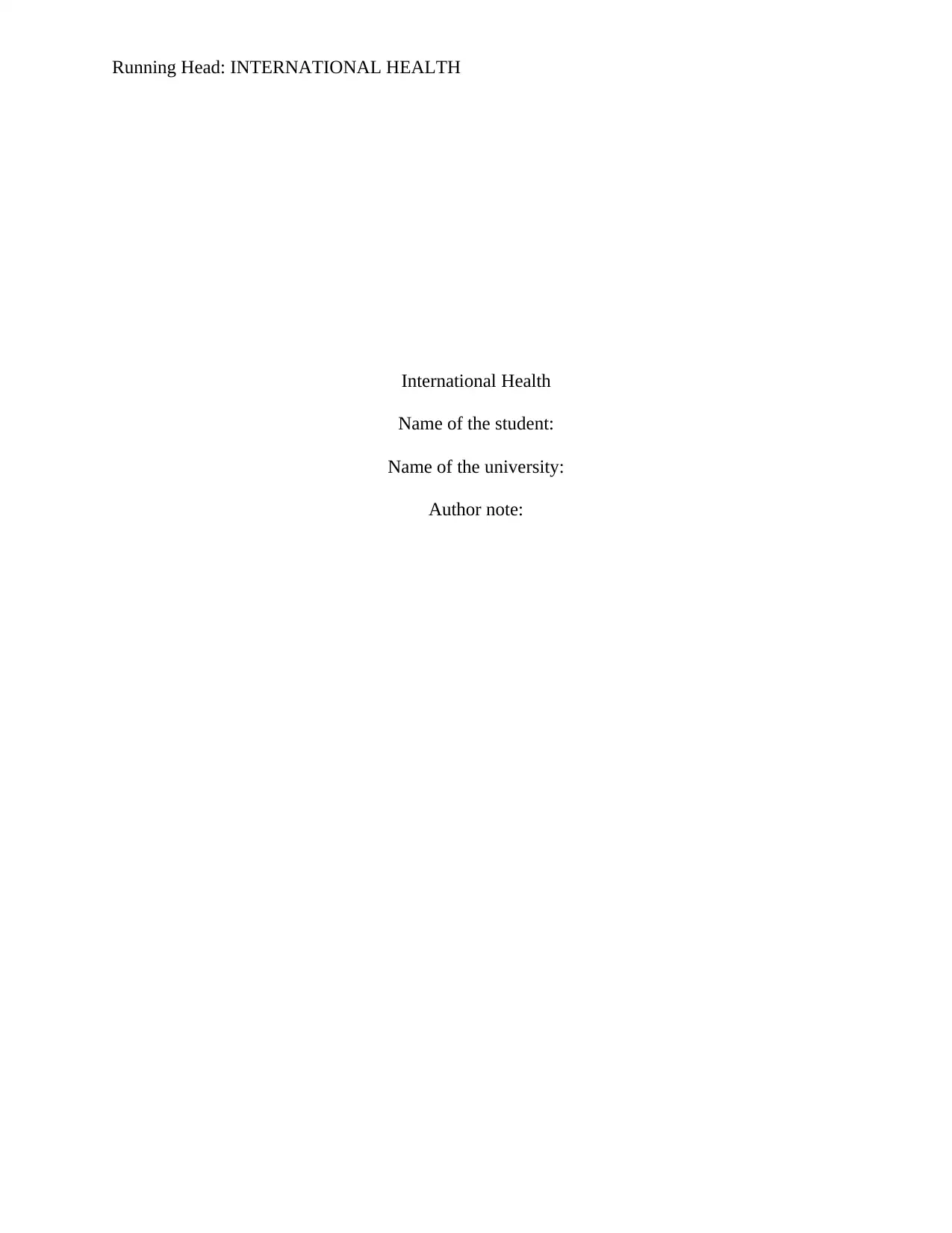
Running Head: INTERNATIONAL HEALTH
International Health
Name of the student:
Name of the university:
Author note:
International Health
Name of the student:
Name of the university:
Author note:
Paraphrase This Document
Need a fresh take? Get an instant paraphrase of this document with our AI Paraphraser
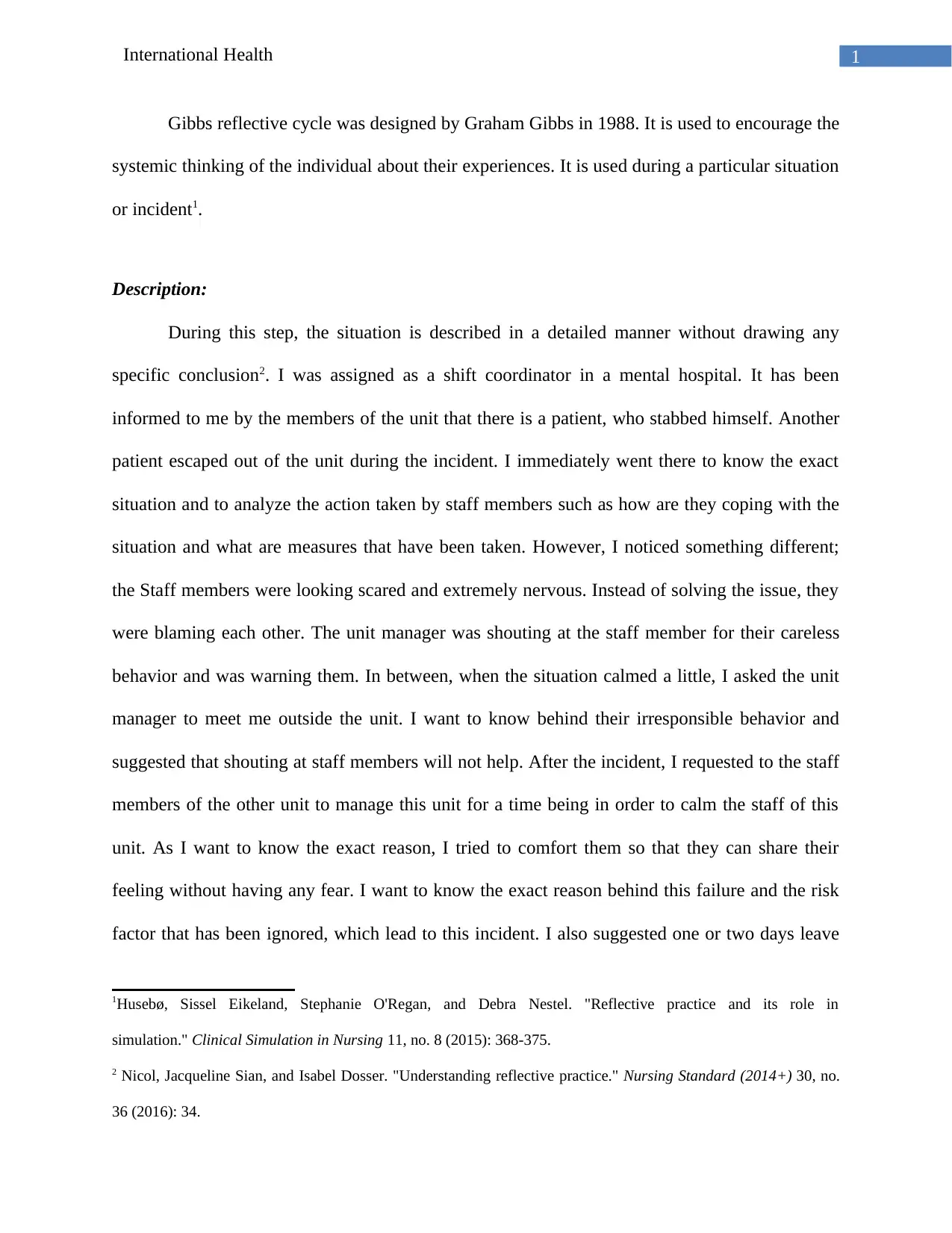
1International Health
Gibbs reflective cycle was designed by Graham Gibbs in 1988. It is used to encourage the
systemic thinking of the individual about their experiences. It is used during a particular situation
or incident1.
Description:
During this step, the situation is described in a detailed manner without drawing any
specific conclusion2. I was assigned as a shift coordinator in a mental hospital. It has been
informed to me by the members of the unit that there is a patient, who stabbed himself. Another
patient escaped out of the unit during the incident. I immediately went there to know the exact
situation and to analyze the action taken by staff members such as how are they coping with the
situation and what are measures that have been taken. However, I noticed something different;
the Staff members were looking scared and extremely nervous. Instead of solving the issue, they
were blaming each other. The unit manager was shouting at the staff member for their careless
behavior and was warning them. In between, when the situation calmed a little, I asked the unit
manager to meet me outside the unit. I want to know behind their irresponsible behavior and
suggested that shouting at staff members will not help. After the incident, I requested to the staff
members of the other unit to manage this unit for a time being in order to calm the staff of this
unit. As I want to know the exact reason, I tried to comfort them so that they can share their
feeling without having any fear. I want to know the exact reason behind this failure and the risk
factor that has been ignored, which lead to this incident. I also suggested one or two days leave
1Husebø, Sissel Eikeland, Stephanie O'Regan, and Debra Nestel. "Reflective practice and its role in
simulation." Clinical Simulation in Nursing 11, no. 8 (2015): 368-375.
2 Nicol, Jacqueline Sian, and Isabel Dosser. "Understanding reflective practice." Nursing Standard (2014+) 30, no.
36 (2016): 34.
Gibbs reflective cycle was designed by Graham Gibbs in 1988. It is used to encourage the
systemic thinking of the individual about their experiences. It is used during a particular situation
or incident1.
Description:
During this step, the situation is described in a detailed manner without drawing any
specific conclusion2. I was assigned as a shift coordinator in a mental hospital. It has been
informed to me by the members of the unit that there is a patient, who stabbed himself. Another
patient escaped out of the unit during the incident. I immediately went there to know the exact
situation and to analyze the action taken by staff members such as how are they coping with the
situation and what are measures that have been taken. However, I noticed something different;
the Staff members were looking scared and extremely nervous. Instead of solving the issue, they
were blaming each other. The unit manager was shouting at the staff member for their careless
behavior and was warning them. In between, when the situation calmed a little, I asked the unit
manager to meet me outside the unit. I want to know behind their irresponsible behavior and
suggested that shouting at staff members will not help. After the incident, I requested to the staff
members of the other unit to manage this unit for a time being in order to calm the staff of this
unit. As I want to know the exact reason, I tried to comfort them so that they can share their
feeling without having any fear. I want to know the exact reason behind this failure and the risk
factor that has been ignored, which lead to this incident. I also suggested one or two days leave
1Husebø, Sissel Eikeland, Stephanie O'Regan, and Debra Nestel. "Reflective practice and its role in
simulation." Clinical Simulation in Nursing 11, no. 8 (2015): 368-375.
2 Nicol, Jacqueline Sian, and Isabel Dosser. "Understanding reflective practice." Nursing Standard (2014+) 30, no.
36 (2016): 34.
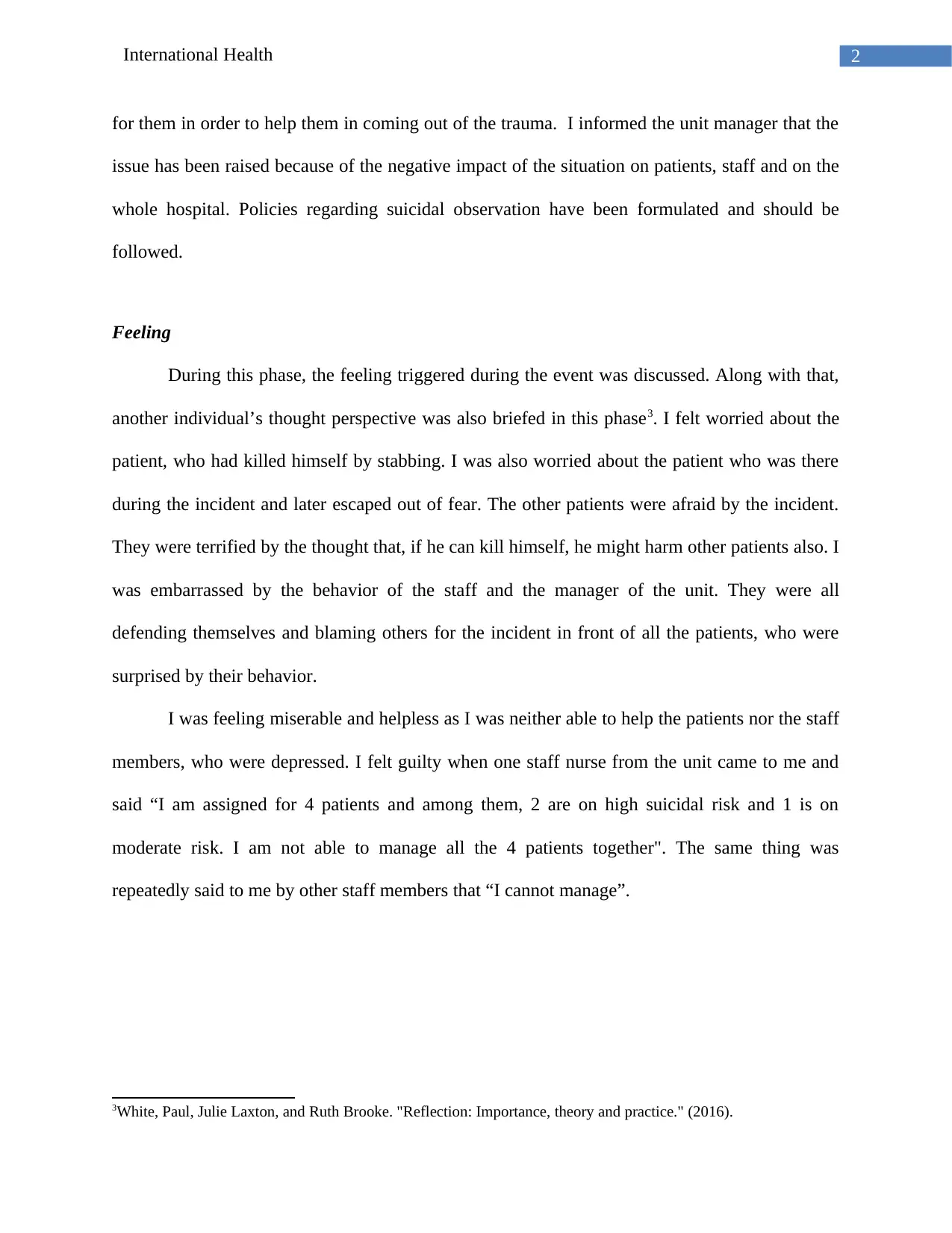
2International Health
for them in order to help them in coming out of the trauma. I informed the unit manager that the
issue has been raised because of the negative impact of the situation on patients, staff and on the
whole hospital. Policies regarding suicidal observation have been formulated and should be
followed.
Feeling
During this phase, the feeling triggered during the event was discussed. Along with that,
another individual’s thought perspective was also briefed in this phase3. I felt worried about the
patient, who had killed himself by stabbing. I was also worried about the patient who was there
during the incident and later escaped out of fear. The other patients were afraid by the incident.
They were terrified by the thought that, if he can kill himself, he might harm other patients also. I
was embarrassed by the behavior of the staff and the manager of the unit. They were all
defending themselves and blaming others for the incident in front of all the patients, who were
surprised by their behavior.
I was feeling miserable and helpless as I was neither able to help the patients nor the staff
members, who were depressed. I felt guilty when one staff nurse from the unit came to me and
said “I am assigned for 4 patients and among them, 2 are on high suicidal risk and 1 is on
moderate risk. I am not able to manage all the 4 patients together". The same thing was
repeatedly said to me by other staff members that “I cannot manage”.
3White, Paul, Julie Laxton, and Ruth Brooke. "Reflection: Importance, theory and practice." (2016).
for them in order to help them in coming out of the trauma. I informed the unit manager that the
issue has been raised because of the negative impact of the situation on patients, staff and on the
whole hospital. Policies regarding suicidal observation have been formulated and should be
followed.
Feeling
During this phase, the feeling triggered during the event was discussed. Along with that,
another individual’s thought perspective was also briefed in this phase3. I felt worried about the
patient, who had killed himself by stabbing. I was also worried about the patient who was there
during the incident and later escaped out of fear. The other patients were afraid by the incident.
They were terrified by the thought that, if he can kill himself, he might harm other patients also. I
was embarrassed by the behavior of the staff and the manager of the unit. They were all
defending themselves and blaming others for the incident in front of all the patients, who were
surprised by their behavior.
I was feeling miserable and helpless as I was neither able to help the patients nor the staff
members, who were depressed. I felt guilty when one staff nurse from the unit came to me and
said “I am assigned for 4 patients and among them, 2 are on high suicidal risk and 1 is on
moderate risk. I am not able to manage all the 4 patients together". The same thing was
repeatedly said to me by other staff members that “I cannot manage”.
3White, Paul, Julie Laxton, and Ruth Brooke. "Reflection: Importance, theory and practice." (2016).
⊘ This is a preview!⊘
Do you want full access?
Subscribe today to unlock all pages.

Trusted by 1+ million students worldwide
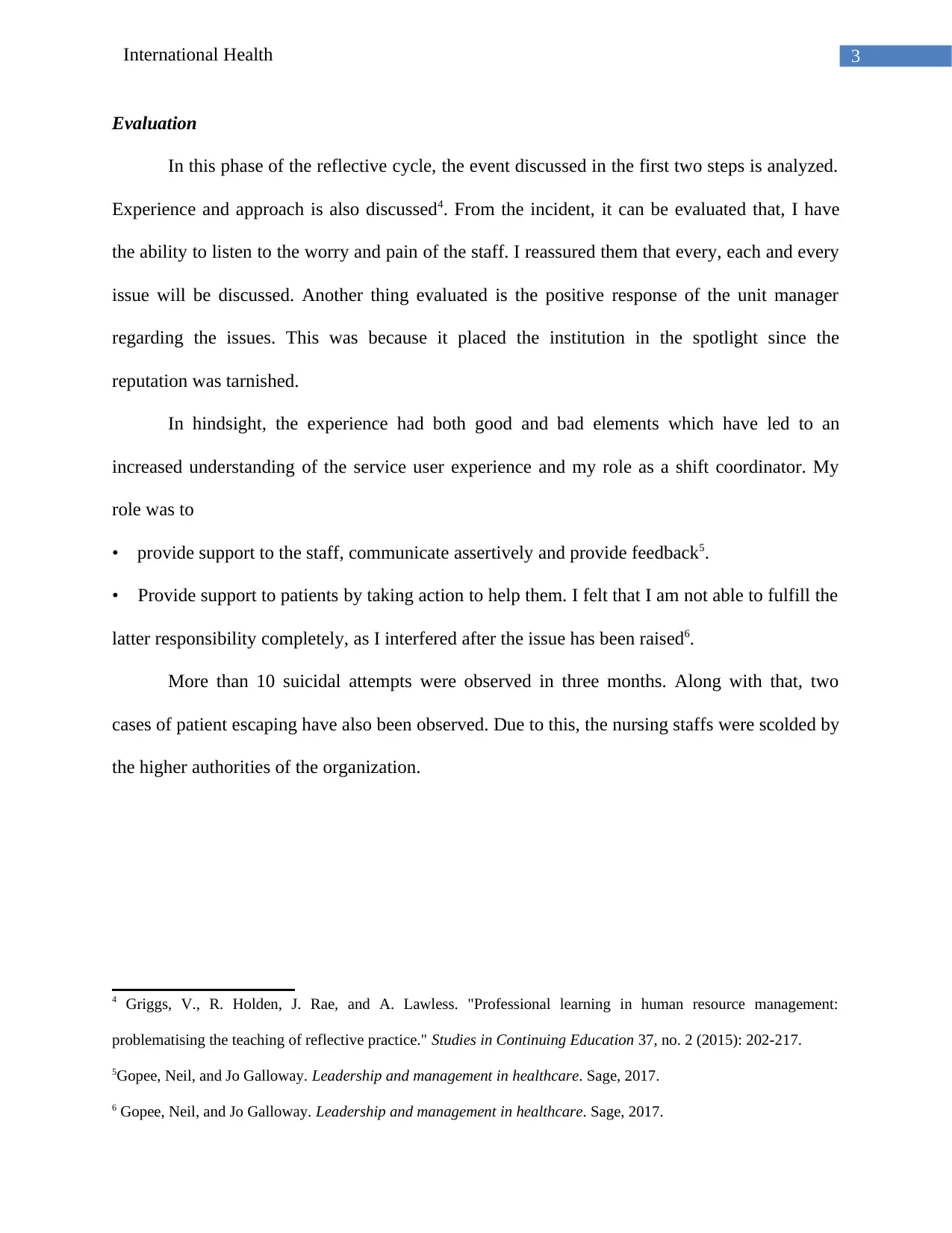
3International Health
Evaluation
In this phase of the reflective cycle, the event discussed in the first two steps is analyzed.
Experience and approach is also discussed4. From the incident, it can be evaluated that, I have
the ability to listen to the worry and pain of the staff. I reassured them that every, each and every
issue will be discussed. Another thing evaluated is the positive response of the unit manager
regarding the issues. This was because it placed the institution in the spotlight since the
reputation was tarnished.
In hindsight, the experience had both good and bad elements which have led to an
increased understanding of the service user experience and my role as a shift coordinator. My
role was to
• provide support to the staff, communicate assertively and provide feedback5.
• Provide support to patients by taking action to help them. I felt that I am not able to fulfill the
latter responsibility completely, as I interfered after the issue has been raised6.
More than 10 suicidal attempts were observed in three months. Along with that, two
cases of patient escaping have also been observed. Due to this, the nursing staffs were scolded by
the higher authorities of the organization.
4 Griggs, V., R. Holden, J. Rae, and A. Lawless. "Professional learning in human resource management:
problematising the teaching of reflective practice." Studies in Continuing Education 37, no. 2 (2015): 202-217.
5Gopee, Neil, and Jo Galloway. Leadership and management in healthcare. Sage, 2017.
6 Gopee, Neil, and Jo Galloway. Leadership and management in healthcare. Sage, 2017.
Evaluation
In this phase of the reflective cycle, the event discussed in the first two steps is analyzed.
Experience and approach is also discussed4. From the incident, it can be evaluated that, I have
the ability to listen to the worry and pain of the staff. I reassured them that every, each and every
issue will be discussed. Another thing evaluated is the positive response of the unit manager
regarding the issues. This was because it placed the institution in the spotlight since the
reputation was tarnished.
In hindsight, the experience had both good and bad elements which have led to an
increased understanding of the service user experience and my role as a shift coordinator. My
role was to
• provide support to the staff, communicate assertively and provide feedback5.
• Provide support to patients by taking action to help them. I felt that I am not able to fulfill the
latter responsibility completely, as I interfered after the issue has been raised6.
More than 10 suicidal attempts were observed in three months. Along with that, two
cases of patient escaping have also been observed. Due to this, the nursing staffs were scolded by
the higher authorities of the organization.
4 Griggs, V., R. Holden, J. Rae, and A. Lawless. "Professional learning in human resource management:
problematising the teaching of reflective practice." Studies in Continuing Education 37, no. 2 (2015): 202-217.
5Gopee, Neil, and Jo Galloway. Leadership and management in healthcare. Sage, 2017.
6 Gopee, Neil, and Jo Galloway. Leadership and management in healthcare. Sage, 2017.
Paraphrase This Document
Need a fresh take? Get an instant paraphrase of this document with our AI Paraphraser
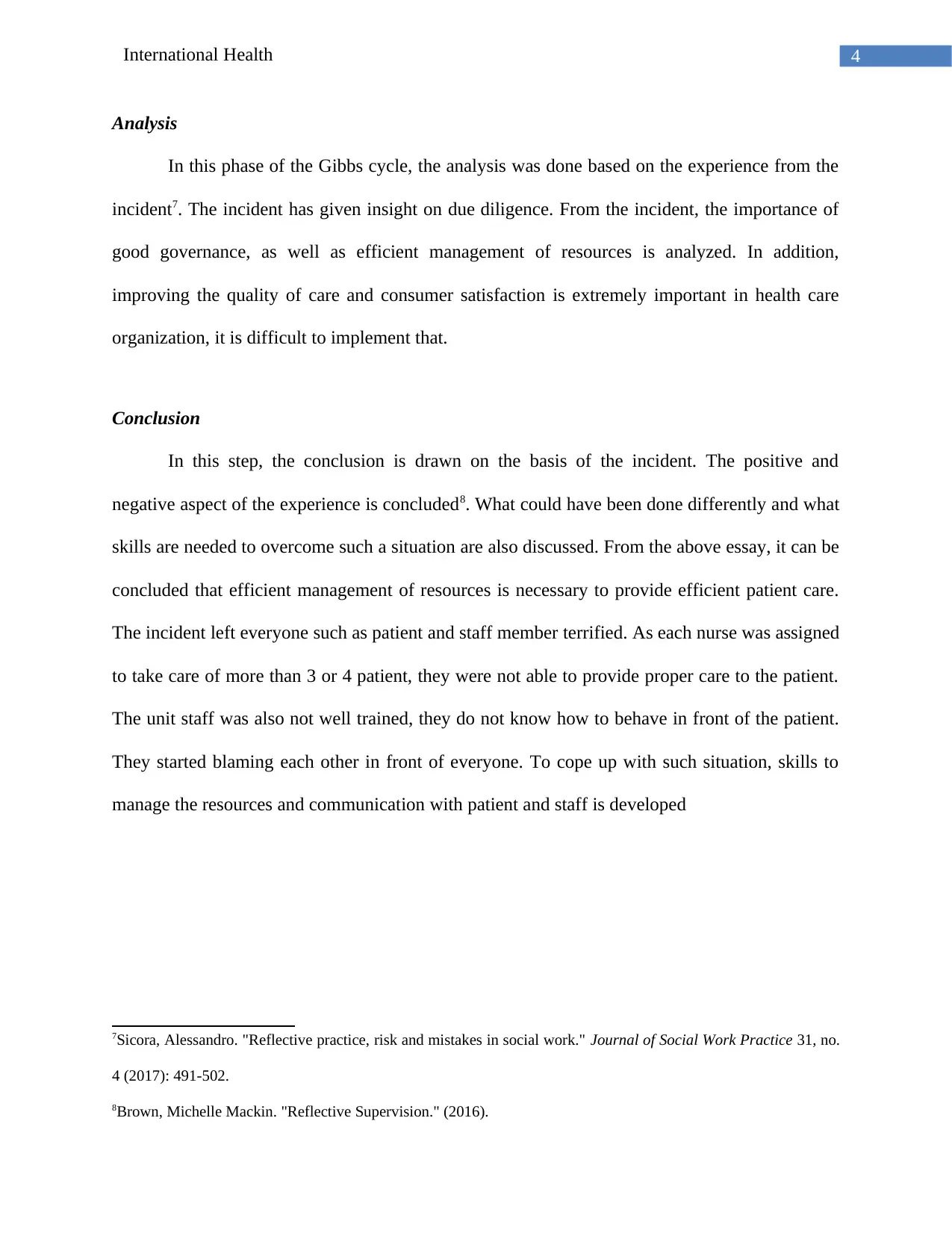
4International Health
Analysis
In this phase of the Gibbs cycle, the analysis was done based on the experience from the
incident7. The incident has given insight on due diligence. From the incident, the importance of
good governance, as well as efficient management of resources is analyzed. In addition,
improving the quality of care and consumer satisfaction is extremely important in health care
organization, it is difficult to implement that.
Conclusion
In this step, the conclusion is drawn on the basis of the incident. The positive and
negative aspect of the experience is concluded8. What could have been done differently and what
skills are needed to overcome such a situation are also discussed. From the above essay, it can be
concluded that efficient management of resources is necessary to provide efficient patient care.
The incident left everyone such as patient and staff member terrified. As each nurse was assigned
to take care of more than 3 or 4 patient, they were not able to provide proper care to the patient.
The unit staff was also not well trained, they do not know how to behave in front of the patient.
They started blaming each other in front of everyone. To cope up with such situation, skills to
manage the resources and communication with patient and staff is developed
7Sicora, Alessandro. "Reflective practice, risk and mistakes in social work." Journal of Social Work Practice 31, no.
4 (2017): 491-502.
8Brown, Michelle Mackin. "Reflective Supervision." (2016).
Analysis
In this phase of the Gibbs cycle, the analysis was done based on the experience from the
incident7. The incident has given insight on due diligence. From the incident, the importance of
good governance, as well as efficient management of resources is analyzed. In addition,
improving the quality of care and consumer satisfaction is extremely important in health care
organization, it is difficult to implement that.
Conclusion
In this step, the conclusion is drawn on the basis of the incident. The positive and
negative aspect of the experience is concluded8. What could have been done differently and what
skills are needed to overcome such a situation are also discussed. From the above essay, it can be
concluded that efficient management of resources is necessary to provide efficient patient care.
The incident left everyone such as patient and staff member terrified. As each nurse was assigned
to take care of more than 3 or 4 patient, they were not able to provide proper care to the patient.
The unit staff was also not well trained, they do not know how to behave in front of the patient.
They started blaming each other in front of everyone. To cope up with such situation, skills to
manage the resources and communication with patient and staff is developed
7Sicora, Alessandro. "Reflective practice, risk and mistakes in social work." Journal of Social Work Practice 31, no.
4 (2017): 491-502.
8Brown, Michelle Mackin. "Reflective Supervision." (2016).
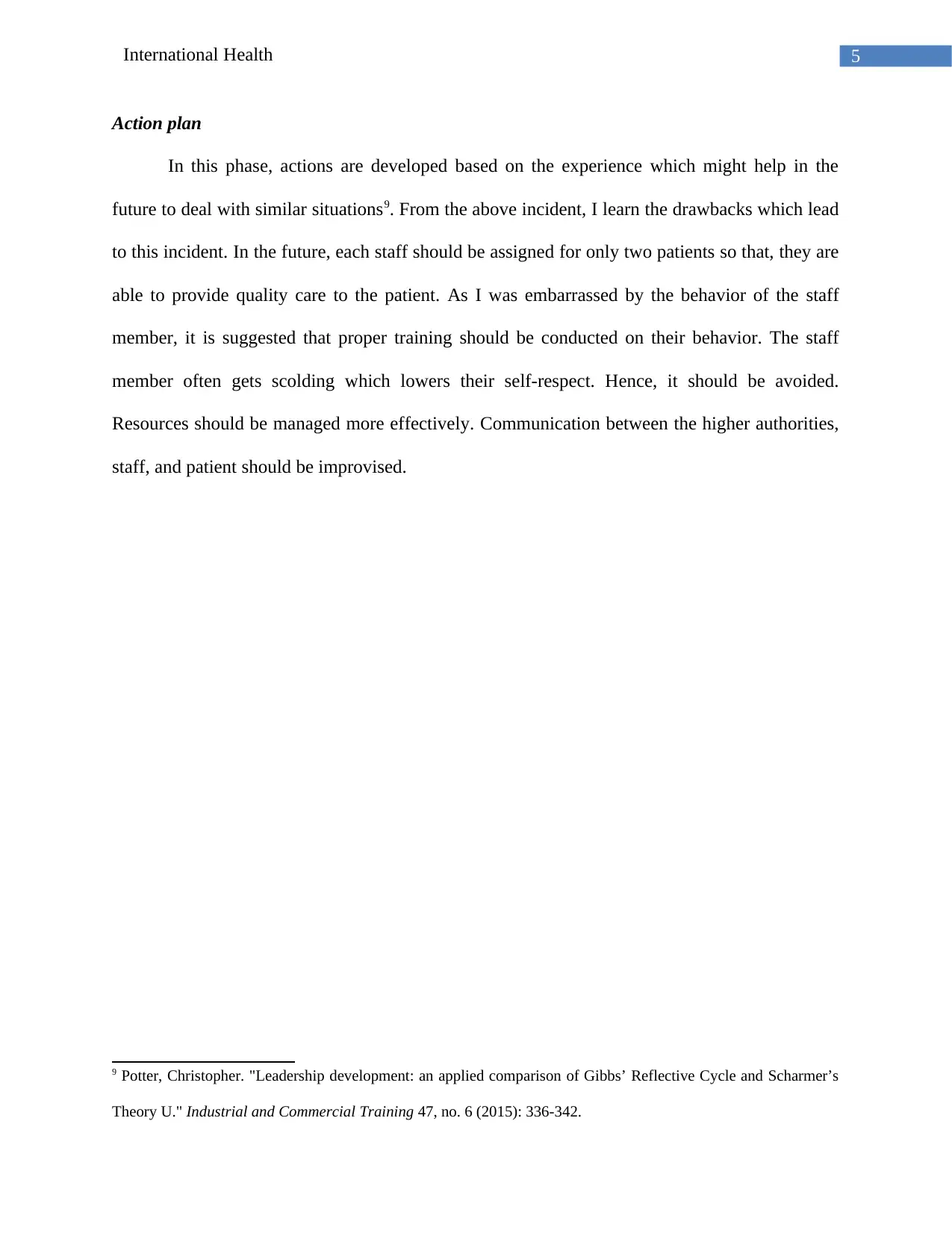
5International Health
Action plan
In this phase, actions are developed based on the experience which might help in the
future to deal with similar situations9. From the above incident, I learn the drawbacks which lead
to this incident. In the future, each staff should be assigned for only two patients so that, they are
able to provide quality care to the patient. As I was embarrassed by the behavior of the staff
member, it is suggested that proper training should be conducted on their behavior. The staff
member often gets scolding which lowers their self-respect. Hence, it should be avoided.
Resources should be managed more effectively. Communication between the higher authorities,
staff, and patient should be improvised.
9 Potter, Christopher. "Leadership development: an applied comparison of Gibbs’ Reflective Cycle and Scharmer’s
Theory U." Industrial and Commercial Training 47, no. 6 (2015): 336-342.
Action plan
In this phase, actions are developed based on the experience which might help in the
future to deal with similar situations9. From the above incident, I learn the drawbacks which lead
to this incident. In the future, each staff should be assigned for only two patients so that, they are
able to provide quality care to the patient. As I was embarrassed by the behavior of the staff
member, it is suggested that proper training should be conducted on their behavior. The staff
member often gets scolding which lowers their self-respect. Hence, it should be avoided.
Resources should be managed more effectively. Communication between the higher authorities,
staff, and patient should be improvised.
9 Potter, Christopher. "Leadership development: an applied comparison of Gibbs’ Reflective Cycle and Scharmer’s
Theory U." Industrial and Commercial Training 47, no. 6 (2015): 336-342.
⊘ This is a preview!⊘
Do you want full access?
Subscribe today to unlock all pages.

Trusted by 1+ million students worldwide
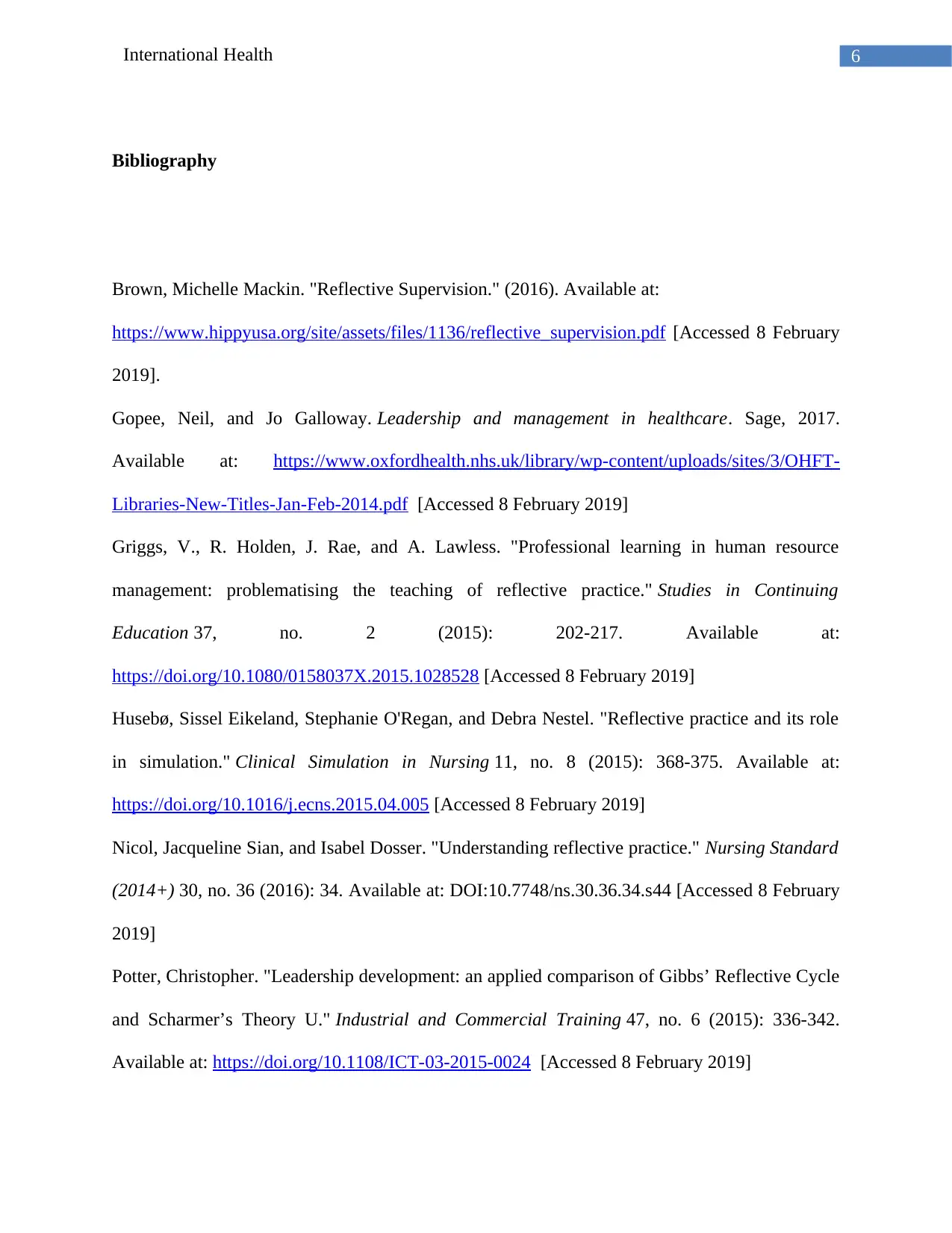
6International Health
Bibliography
Brown, Michelle Mackin. "Reflective Supervision." (2016). Available at:
https://www.hippyusa.org/site/assets/files/1136/reflective_supervision.pdf [Accessed 8 February
2019].
Gopee, Neil, and Jo Galloway. Leadership and management in healthcare. Sage, 2017.
Available at: https://www.oxfordhealth.nhs.uk/library/wp-content/uploads/sites/3/OHFT-
Libraries-New-Titles-Jan-Feb-2014.pdf [Accessed 8 February 2019]
Griggs, V., R. Holden, J. Rae, and A. Lawless. "Professional learning in human resource
management: problematising the teaching of reflective practice." Studies in Continuing
Education 37, no. 2 (2015): 202-217. Available at:
https://doi.org/10.1080/0158037X.2015.1028528 [Accessed 8 February 2019]
Husebø, Sissel Eikeland, Stephanie O'Regan, and Debra Nestel. "Reflective practice and its role
in simulation." Clinical Simulation in Nursing 11, no. 8 (2015): 368-375. Available at:
https://doi.org/10.1016/j.ecns.2015.04.005 [Accessed 8 February 2019]
Nicol, Jacqueline Sian, and Isabel Dosser. "Understanding reflective practice." Nursing Standard
(2014+) 30, no. 36 (2016): 34. Available at: DOI:10.7748/ns.30.36.34.s44 [Accessed 8 February
2019]
Potter, Christopher. "Leadership development: an applied comparison of Gibbs’ Reflective Cycle
and Scharmer’s Theory U." Industrial and Commercial Training 47, no. 6 (2015): 336-342.
Available at: https://doi.org/10.1108/ICT-03-2015-0024 [Accessed 8 February 2019]
Bibliography
Brown, Michelle Mackin. "Reflective Supervision." (2016). Available at:
https://www.hippyusa.org/site/assets/files/1136/reflective_supervision.pdf [Accessed 8 February
2019].
Gopee, Neil, and Jo Galloway. Leadership and management in healthcare. Sage, 2017.
Available at: https://www.oxfordhealth.nhs.uk/library/wp-content/uploads/sites/3/OHFT-
Libraries-New-Titles-Jan-Feb-2014.pdf [Accessed 8 February 2019]
Griggs, V., R. Holden, J. Rae, and A. Lawless. "Professional learning in human resource
management: problematising the teaching of reflective practice." Studies in Continuing
Education 37, no. 2 (2015): 202-217. Available at:
https://doi.org/10.1080/0158037X.2015.1028528 [Accessed 8 February 2019]
Husebø, Sissel Eikeland, Stephanie O'Regan, and Debra Nestel. "Reflective practice and its role
in simulation." Clinical Simulation in Nursing 11, no. 8 (2015): 368-375. Available at:
https://doi.org/10.1016/j.ecns.2015.04.005 [Accessed 8 February 2019]
Nicol, Jacqueline Sian, and Isabel Dosser. "Understanding reflective practice." Nursing Standard
(2014+) 30, no. 36 (2016): 34. Available at: DOI:10.7748/ns.30.36.34.s44 [Accessed 8 February
2019]
Potter, Christopher. "Leadership development: an applied comparison of Gibbs’ Reflective Cycle
and Scharmer’s Theory U." Industrial and Commercial Training 47, no. 6 (2015): 336-342.
Available at: https://doi.org/10.1108/ICT-03-2015-0024 [Accessed 8 February 2019]
Paraphrase This Document
Need a fresh take? Get an instant paraphrase of this document with our AI Paraphraser
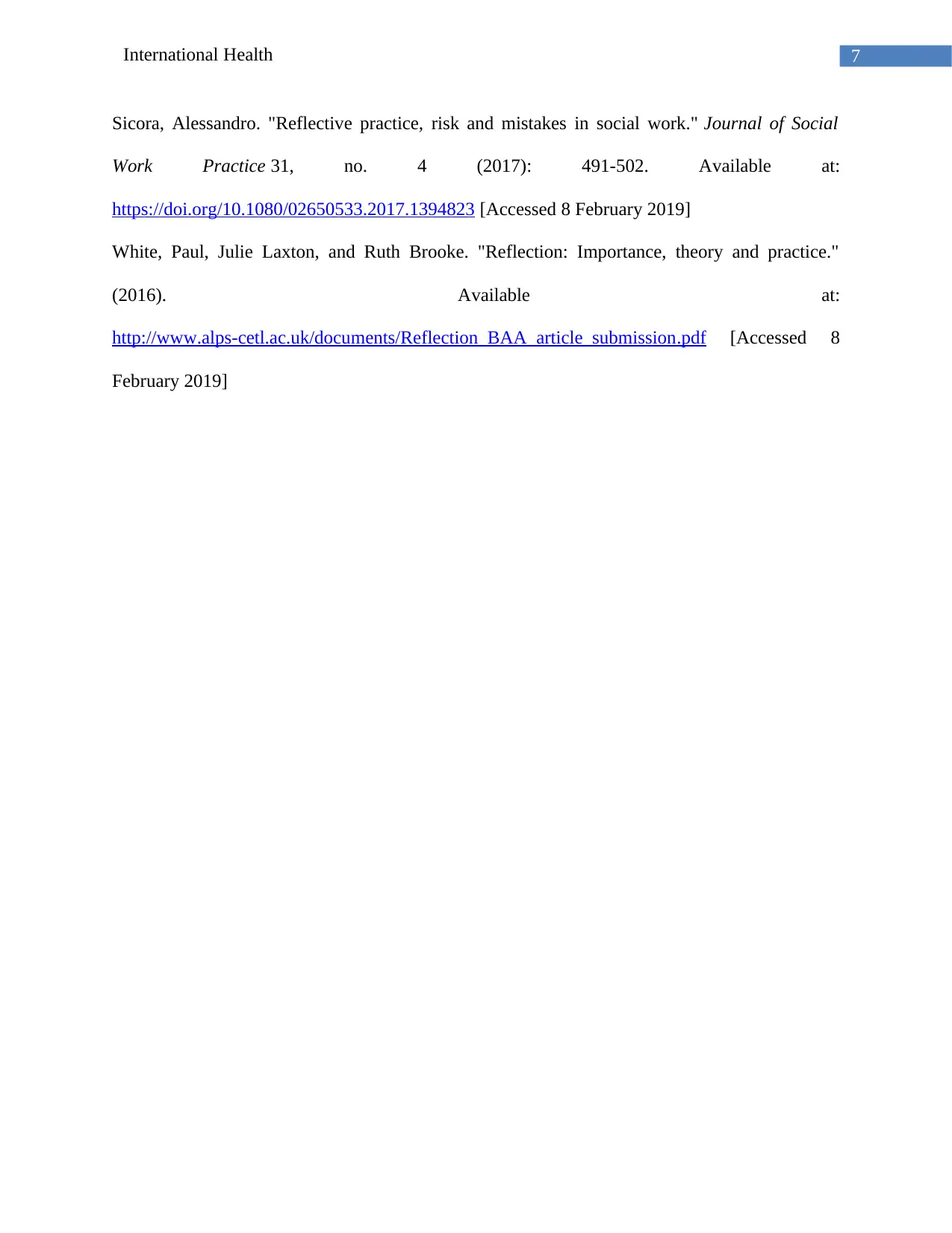
7International Health
Sicora, Alessandro. "Reflective practice, risk and mistakes in social work." Journal of Social
Work Practice 31, no. 4 (2017): 491-502. Available at:
https://doi.org/10.1080/02650533.2017.1394823 [Accessed 8 February 2019]
White, Paul, Julie Laxton, and Ruth Brooke. "Reflection: Importance, theory and practice."
(2016). Available at:
http://www.alps-cetl.ac.uk/documents/Reflection_BAA_article_submission.pdf [Accessed 8
February 2019]
Sicora, Alessandro. "Reflective practice, risk and mistakes in social work." Journal of Social
Work Practice 31, no. 4 (2017): 491-502. Available at:
https://doi.org/10.1080/02650533.2017.1394823 [Accessed 8 February 2019]
White, Paul, Julie Laxton, and Ruth Brooke. "Reflection: Importance, theory and practice."
(2016). Available at:
http://www.alps-cetl.ac.uk/documents/Reflection_BAA_article_submission.pdf [Accessed 8
February 2019]
1 out of 8
Related Documents
Your All-in-One AI-Powered Toolkit for Academic Success.
+13062052269
info@desklib.com
Available 24*7 on WhatsApp / Email
![[object Object]](/_next/static/media/star-bottom.7253800d.svg)
Unlock your academic potential
Copyright © 2020–2025 A2Z Services. All Rights Reserved. Developed and managed by ZUCOL.




